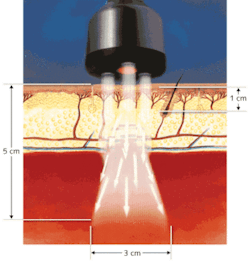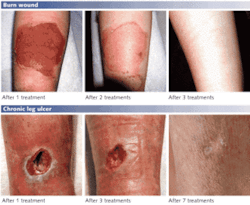PHOTONICS APPLIED: PHOTONICS IN MEDICINE: Low-level light therapy: It’s all about wavelength and power

Sunlight not only enables humans to produce vitamin D in their bodies, but it has long been believed to cure many maladies. In fact, lack of sunlight is thought to cause a neurochemical imbalance in the brain that is responsible for an illness called seasonal affective disorder (SAD)—common in cloudy cities like Seattle, WA—that causes depression and anxiety. However, sunlight in large doses can also cause skin cancer. Clearly, the application of natural and synthetic forms of electromagnetic radiation—formerly called biostimulation but now more commonly known as low-level light therapy (LLLT) or photonic therapy—is entirely a matter of wavelength, power level, and duration.
Since its beginnings in 1967, when Hungarian physician and surgeon Endre Mester used ruby and helium-neon (He-Ne) lasers for studies in wound healing, LLLT has remained an active area of research, with companies like Irradia (Stockholm, Sweden), MedSolution (Radolfzell, Germany), SpectraVET (Oakbank, Australia), Laser Therapeutics (Tucson, AZ), Erchonia Medical (McKinney, TX), and Theralase Technologies (Toronto, ON, Canada) offering hundreds of wavelength-specific LLLT solutions.1, 2
In 2002, the ML 830 laser from MicroLight Corporation of America (Missouri City, TX) was the first laser to receive clearance from the U.S. Food and Drug Administration (FDA)—after 12 years, two double-blind studies, and $4 million in fees—for the nonsurgical treatment of carpal tunnel syndrome. The ML 830 is now being applied for pain management, sports injury, and trigger-point therapy for fibromyalgia, arthritis, and even neuromuscular disorders such as Bell’s Palsy (see Fig. 1). While the U.S. was slow to approve the laser (Europe and Asia approved LLLT devices in the early 1980s), the FDA now recognizes the legitimacy of this therapy and actively investigates safety, claims, and labeling for all photonic-therapy devices.
Wavelength-specific therapies
When discussing LLLT, it is important to distinguish it as the direct application of laser, LED, or other structured light to a patient for the purpose of offering some healing benefit.
First applied in the field of veterinary medicine, light therapy using red light (632 nm) has a beneficial effect on animals in the treatment of pain associated with tissue injury (see www.vomtech.com/vetcoldlaser.html). “For the last eight years we have been mapping out the specific laser frequencies and protocols for animals—mostly dogs, cats, and horses—serving as a sort-of ‘clearing house’ for over 120 animal laser practitioners who provide us with additional clinical applications of LLLT,” says William L. Inman, a practicing veterinarian who offers seminars on veterinary cold-laser therapy. “Frustratingly, at times we are reluctant to state what this technology can actually do, as my colleagues do not believe that such results are possible—until they try and apply the technique, of course.” Inman says that red and infrared light has proven effects at the cellular level, repairing mitochondrial and messenger DNA to support and maintain metabolism in the cell and promote healing
Longer infrared wavelengths at 830 nm offer the greatest tissue penetration depth for muscle-healing applications. For example, Inman points to a randomized, double-blind, placebo-controlled study of LLLT in 90 subjects with chronic neck pain using a 300 mW, 830 nm laser at Castle Hill Medical Centre in Australia.3 The study showed that LLLT, with the parameters used in the study, was effective in providing pain relief for patients with chronic neck pain over a period of three months.
The Oralase device from MedX Health (Mississauga, ON, Canada) reduces bleeding, pain, and swelling after dental procedures, and also promotes bone regeneration. Oralase uses a coontinuous-wave 808 nm, 200 mW gallium aluminum arsenide (GaAlAs) laser diode with three red LEDs to guide the infrared healing beam. Another emerging 808 nm application is the noninvasive treatment of ischemic stroke using PhotoThera’s (Carlsbad, CA) NeuroThera laser. Currently undergoing medical trials, NeuroThera offers the only nonsurgical, nonchemical treatment for stroke patients within 24 hours of the appearance of symptoms.
A study of 5000 patients showed that high-dose, cold laser light can improve such hearing problems as tinnitus, oversensitive hearing, ear pressure, vertigo, and even hearing loss.4 Lutz Wilden, a medical doctor and LLLT specialist practicing in Germany (www.dr-wilden.de), said the study revealed that LLLT improved hearing loss by 20% on average, with younger patients showing improvement up to 25 decibels or 50%. The study showed that wavelengths between 630 and 830 nm excited the production of adenosine triphosphate (ATP), which is produced by cell mitochondria, causing natural and accelerated regeneration of hearing cells.
Shorter wavelengths at 577 nm (yellow light) are exactly matched to the main absorption peak of oxygenated hemoglobin and are crucial to photocoagulation treatments that slow the progression of macular degeneration and diabetic retinopathy; Coherent (Santa Clara, CA) won the 2008 PhAST/Laser Focus World Innovation Award for its optically pumped semiconductor laser (OPSL) targeting this 577 nm wavelength.
The even shorter 532 nm wavelength output from a potassium titanyl phosphate (KTP) laser has a profound effect on healing diabetic and other ulcerated open wounds that do not heal after months of traditional treatment with antibiotic and other creams. With a single treatment consisting of 60 mW, 532 nm laser light at 0.5 J/cm2 applied to the central portion of the wound, working in concert with 650 nm 1.0 J/cm2 light applied at the wound edges and 240 mW of 904 nm light applied just outside the wound, Swedish Laser Medical Society (SLMS) certified laser therapist Christina Bäckström and colleagues from Irradia (Stockholm, Sweden) have demonstrated complete healing of ulcers and burns with as little as seven (one per week) five-minute treatments (see Fig. 2).Canadian researchers demonstrated even finer LLLT wavelength specificity by showing that 290 to 320 nm light, but not the 254 nm light studied previously, was instrumental in cellular processes that can prevent skin cancer.5
At the cellular level
A 2006 article in Lasers in Surgery and Medicine reports that low-level doses of laser irradiation have “a stimulatory influence on wounded fibroblasts with an increase in cell proliferation and cell viability without adversely increasing the amount of cellular and molecular damage.”6 For example, Levon Gasparyan, MD, has studied the He-Ne laser at 632.8 nm in intravenous laser blood irradiation (IV LBI). A 1-to-3 mW dose of light is applied for 20 to 60 minutes daily, for three to ten days. Studies show that IV LBI stimulates the immune response of the organism, activates erythrogenesis and improves deformability of erythrocyte membranes, has antihypoxic activity on tissues, and has general antitoxic influence on the organism at different pathological processes. Additional accolades of IV LBI include that it is biostimulative, analgetic, antiallergic, immunocorrective, vasodilative, antibacterial, anti-inflammatory, among others.
Andrei P. Sommer, senior scientist in the Nanobionic Laboratory at the Institute of Micro and Nanotechnology at the University of Ulm (Ulm, Germany) has focused his work on understanding how light therapy works at the cellular level. Sommer and his colleague Dan Zhu study the physiochemical effect of light in both cells and the extracellular matrix. Their work offers new insights on the effect of low-level light on interfacial water layers on biological surfaces such as elastin in human skin (see Fig. 3).7 “There are three basic parameters that must be observed in low-level light photobiostimulation: intensity, energy density, and wavelength,” says Sommer. “The golden rule, empirically found by Endre Mester, is that the energy density has to be between 1 and 4 J/cm2; however, if the intensity of the light is too low, there is no biological effect.”Sommer cites a pioneering study in 1981 that irradiated the open-skin wounds of rats daily with a He-Ne laser (632.8 nm) and an argon laser (514.5 nm) at 45 mW/cm2.8 The He-Ne laser radiation had a statistically significant stimulating effect on collagen synthesis in the wound, with a maximum effect at an energy density of 4 J/cm2 and the rate of wound closure was enhanced significantly between the third and twelfth postoperative days. The argon-laser exposure produced a significant increase in collagen concentration; however, an acceleration of the healing rate was not seen in this case. The study surmises that there is a wavelength-selective influence of coherent light on the metabolic and proliferation processes in wound healing. With higher exposures at 20 J/cm2, wound healing was inhibited.
FDA compliance
Like anything in life, too much of a good thing can sometimes have negative consequences. Even though “cold lasers” used in LLLT applications are considered nonthermal and safe, the FDA’s Center for Devices and Radiological Health (CDRH) Manufacturer and User Facility Device Experience (MAUDE) database reports that patient burns and pain during therapeutic treatment are not unheard of.9 “The key to safe application of low-level laser light is keeping the radiation at a low level,” says Michael Barbour, president and founder of MicroLight. “The FDA has designated any laser with a power level below 100 mW as a nonheating laser with ‘NHN’ designation; devices above 100 mW that relieve pain through heating are designated ‘ILY.’ Our MicroLight laser is a 90 mW Class IIIb device with no negative patient reports. Unfortunately, many of the Class IV laser and LED devices coming on the market today have higher powers and are burning people.”
Indeed, the 2006 Lasers in Surgery and Medicine report previously cited also warns, “Higher [laser intensity] doses were characterized by a decrease in cell viability and cell proliferation with a significant amount of damage to the cell membrane and DNA.” Barbour believes the key to success of LLLT is to provide true nonthermal, low-power-level laser devices to the marketplace and educating physicians and clinicians about safe and effective use of such therapies.
REFERENCES
- E. Mester, B. Szende, and J. G. Tota, Kiserl Orvostud 19, p. 628 (1967).
- www.laserworld.org, the Swedish Laser Medical Society LLLT Internet Guide, listing editorial, scientific abstracts, manufacturers of LLLT equipment.
- www.ncbi.nlm.nih.gov/pubmed/16806710?dopt=AbstractPlus.
- L. Wilden and D. Ellerbrock, Lasermedizin 14, p. 129 (1998).
- G. Mathonnet et al., PNAS 100(12) p. 7219 (June 10, 2003).
- D. H. Hawkins et al., Lasers in Surgery and Medicine 38, p. 74 (2006).
- A. P. Sommer and D. Zhu, Crystal Growth & Design 8(11) p. 3889 (2008).
- J. S. Kana et al., Archives of Surgery 116(3) p. 293 (March 1981).
- www.accessdata.fda.gov/scripts/cdrh/cfdocs/cfMAUDE/search.CFM.

Gail Overton | Senior Editor (2004-2020)
Gail has more than 30 years of engineering, marketing, product management, and editorial experience in the photonics and optical communications industry. Before joining the staff at Laser Focus World in 2004, she held many product management and product marketing roles in the fiber-optics industry, most notably at Hughes (El Segundo, CA), GTE Labs (Waltham, MA), Corning (Corning, NY), Photon Kinetics (Beaverton, OR), and Newport Corporation (Irvine, CA). During her marketing career, Gail published articles in WDM Solutions and Sensors magazine and traveled internationally to conduct product and sales training. Gail received her BS degree in physics, with an emphasis in optics, from San Diego State University in San Diego, CA in May 1986.

